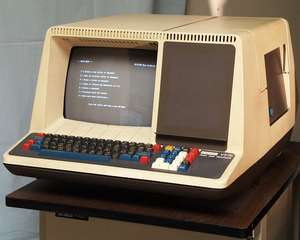
Subject: What is a VT78?
Date of introduction: 1978
Date of withdrawal: 1980 (Displaced by the DECmate)
Also known as:
DECstation
DECstation 78
Price: $7,995 ($5,436 in lots of 100)
Technology: Based on the Intersil/Harris 6100 microprocessor, packaged
in a VT52 case. The 6100 processor was able to run at 4 MHz, but
in the VT78, it was only clocked at 2.2 MHz because of the speed
of the DRAM used and the deliberate use of graded out chips.
Reason for introduction: Using TTL MSI and LSI components, DEC could
pack a system into the vacant space in a standard terminal case,
allowing PDP-8 systems to compete with personal computers in the
small business and office automation market. This was a natural
follow-on to the desk-mounted workstation configurations in which
the PDP-8/A was already being sold.
Compatability: The Group I OPR combinations RAL RAR and RTL RTR are
no-ops. Unlike all earlier PDP-8 models, autoindex locations
10 to 17 (octal) only work in page zero mode; these operate like
all other memory locations when addressed in current page mode
from code running on page zero. Other than this, it is fully
PDP-8/E compatable, even at the level of I/O instructions for
the standard periperals; this was the last PDP-8 to offer this
level of compatability.
It was not possible to continue from a halt without restarting
the machine. In addition, none of the peripherals available on
this machine needed DMA (data break) transfers.
Standard configuration: The VT78 was sold with 16k words of DRAM with
the keyboard and display of the VT52 terminal. An RX01 dual 8"
diskette drive was included, packaged in a teacart pedestal under
the terminal. The console (device 03/04) and the serial ports
(devices 30/31 and 32/33) are compatible with the M8650 KL8E,
with the latter extended to allow software controlled baud rate
selection. There are two parallel ports; device 66 (compatible
with the M8365 printer controller) and device 47, compatible with
the nonstandard port on the M8316 DKC8AA. There is also a 100Hz
clock compatible with the clock on the M8316 DKC8AA.
The standard ROM boots the system from the RX01 after setting the
baud rates to match that selected by the switches on the bottom
of the VT52 case.
Expandability: This was a closed system, with few options. The base
configuration was able to support two RX01 drives (later RX02),
for a total of 4 transports. Various boot ROM's were available,
including a paper-tape RIM loader ROM for loading diagnostics
from tape. Another ROM boots the system from a PDP-11 server in
the client/server configuration used by WPS-11.
Survival: There are probably many VT78 systems still in use.

Current size small. Select Picture size for links below Small Medium Large
Front View (WPS running) ( 33K)
Keyboard ( 20K)